Text

Inside Droplets
Phase separation – two distinct phases separating from a mixture, as vinegar and oil will from an undisturbed salad dressing – into droplets plays a role in the biochemical dynamics and signals within cells. This study uses computer modelling to understand the interaction of networks of the cell's structural protein actin with droplets of the actin binding protein VASP influences cytoskeletal architecture
Read the published research article here
Image from work by Aravind Chandrasekaran and colleagues
Department of Mechanical and Aerospace Engineering, University of California San Diego, La Jolla, CA, USA
Image originally published with a Creative Commons Attribution 4.0 International (CC BY 4.0)
Published in Nature Communications, April 2024
You can also follow BPoD on Instagram, Twitter and Facebook
7 notes
·
View notes
Text
Centriole Building
The centriole – an organelle vital for the faithful separation into each daughter cell when a cell divides – is composed of an assembly of proteins. Using expansion microscopy, this study correlates the spatial location of 24 of those proteins with structural features of the human centriole, and then models the molecular architecture of the centriole as it assembles (shown here)
Read the published research article here
Video from work by Marine H. Laporte and colleagues
University of Geneva, Department of Molecular and Cellular Biology, Faculty of Sciences, Geneva, Switzerland
Video originally published with a Creative Commons Attribution 4.0 International (CC BY-NC 4.0)
Published in Cell, April 2024
You can also follow BPoD on Instagram, Twitter and Facebook
#science#biomedicine#biology#cell division#centrioles#centrosome#computer modeling#expansion microscopy
6 notes
·
View notes
Text
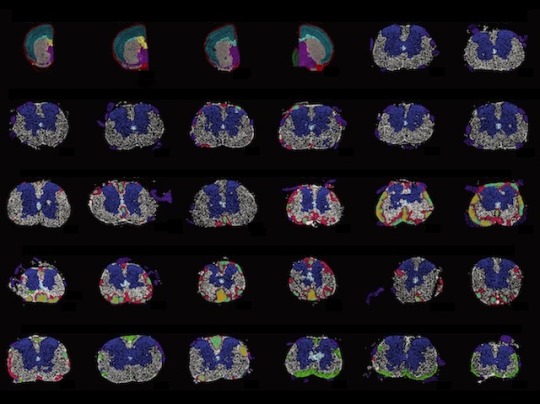
Cord Progression
Details revealed of the regions and timing of multiple sclerosis progression from single cell analyses in a mouse model (experimental autoimmune encephalomyelitis) and in post mortem MS patient spinal cords
Read the published research article here
Image from work by Petra Kukanja and Christoffer M. Langseth, and colleagues
Laboratory of Molecular Neurobiology, Department of Medical Biochemistry and Biophysics, Biomedicum, Karolinska Institutet; Science for Life Laboratory, Department of Biochemistry and Biophysics, Stockholm University, Solna, Stockholm, Sweden
Image originally published with a Creative Commons Attribution 4.0 International (CC BY 4.0)
Published in Cell, March 2024
You can also follow BPoD on Instagram, Twitter and Facebook
11 notes
·
View notes
Text
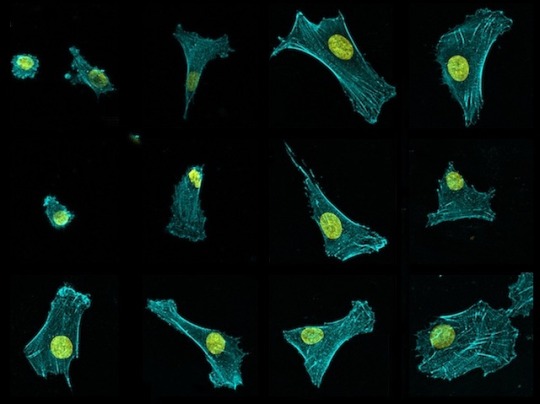
Contractions and Wrinkles
Understanding the factors influencing myoblasts (cells from which skeletal muscle develops). In lab-grown cells, a soft substrate led to more myoblasts with a wrinkled nucleus with a reduced level of a proliferation marker, and lower contractility – a relationship with potential for therapeutic manipulation
Read the published research article here
Image from work by Jo Nguyen and colleagues
Institute of Biomedical Engineering, University of Toronto, Toronto, ON, Canada
Image originally published with a Creative Commons Attribution 4.0 International (CC BY 4.0)
Published in Journal of Cell Science, March 2024
You can also follow BPoD on Instagram, Twitter and Facebook
4 notes
·
View notes
Text

Ear Mending
How the different cell layers of the eardrum contribute to healing as it repairs after perforation, which can occur from trauma, pressure change or inflammation
Read the published research article here
Image from work by Olivia M. Dinwoodie, Abigail S. Tucker and Juan M. Fons
Centre for Craniofacial and Regenerative Biology, Faculty of Dentistry, Oral and Craniofacial Sciences, King's College London, London, UK
Video originally published with a Creative Commons Attribution 4.0 International (CC BY 4.0)
Published in Disease, Models & Mechanisms, March 2024
You can also follow BPoD on Instagram, Twitter and Facebook
#science#biomedicine#biology#histology#immunohistochemistry#eardrum#perforated eardrum#tympanic membrane#hearing#hearing loss
8 notes
·
View notes
Text
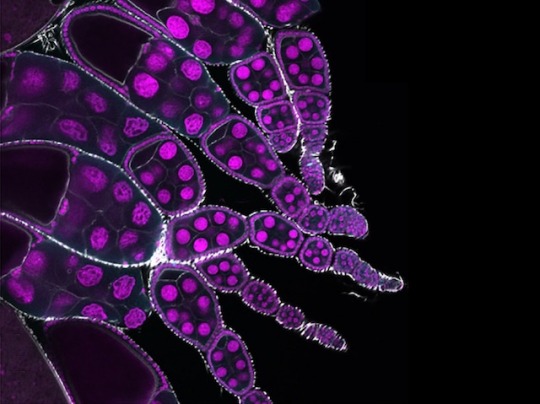
Sensed by Fat
How stress response signalling in fat tissue acts as a metabolic sensor which regulates ovulation and therefore reproduction in the fruit fly provides insight into fat's influence on metabolism and its consequences in vertebrates
Read the published research article here
Image from work by Lydia Grmai and colleagues
Department of Cell Biology, University of Pittsburgh School of Medicine, Pittsburgh, PA, USA
Video originally published with a Creative Commons Attribution 4.0 International (CC BY 4.0)
Published in Cell Reports, March 2024
You can also follow BPoD on Instagram, Twitter and Facebook
#science#biomedicine#immunofluorescence#biology#drosophila#fruit flies#obesity#fat#metabolism#fertility#ovulation
8 notes
·
View notes
Text
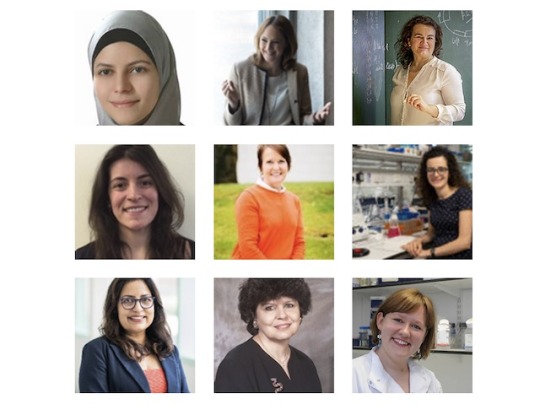
Woman to Woman
Suffrage Science – Life Sciences – Awards 2024
"To showcase and bring prominence to the importance of women in the life sciences, inspiring future generations", the Suffrage Science award scheme was founded in 2011 by cell biologist Professor Amanda Fisher and broadcaster, science communicator and journalist Vivienne Parry
Each award in the form of a piece of jewellery, designed by students from Central Saint Martins-UAL, is passed on by the current holder, down the Suffrage Science lineage like a family heirloom, to someone they admire for their scientific achievements and ability to inspire others
This year's recipients are Dr Areej Abuhammad, University of Jordan, Jordan, Dr Prisca Liberali, FMI, Basel, Switzerland, Dr Frederique Magdinier, Marseille Medical Genetics, France, Dr Azahara Oliva, Cornell University, NY, USA, Prof Lynn Rochester, University of Newcastle, UK, Dr Marta Shahbazi, MRC LMB, Cambridge, UK, Dr Monica Shokeen, Washington University School of Medicine, MO, USA, Prof Faraneh Vargha-Khadem, UCL Institute of Child Health, London, UK, Prof Selina Wray, UCL Queen Square Institute of Neurology, London, UK
Find out more about the background of Suffrage Science and see the heirloom handover, which took place on March 7th at the Department of Biochemistry, University of Oxford, HEREImage copyright held by the Department of Biochemistry, University of Oxford, Oxford, UK
You can also follow BPoD on Instagram, Twitter and Facebook
4 notes
·
View notes
Text

Electrical Orchestration
How hollow organoids – lab-grown 3D tissue models – can be shaped and inflated by external electrical stimulation highlights the role of life's natural bioelectrical systems (as in water regulation) and has potential for applications in fields such as bioengineering and developmental biology
Read the published research article here
Image from work by Gawoon Shim and Isaac B. Breinyn, and colleagues
Department of Mechanical and Aerospace Engineering, Princeton University, Princeton, NJ, USA
Image originally published with a Creative Commons Attribution 4.0 International (CC BY 4.0)
Published in Nature Communications, April 2024
You can also follow BPoD on Instagram, Twitter and Facebook
#science#biomedicine#immunofluorescence#biology#organoids#electrical stimulation#bioelectronics#developmental biology
8 notes
·
View notes
Text

Eye Tune
Activity of neurons of the eye's retina called amacrine cells – recorded by detecting their response to light in combination with electron microscopic reconstruction of the connections made between neurons – reveals local tuning of signals in the retinal tissue to transmit visual information
Read the published research article here
Image from work by Karl Friedrichsen and colleagues
Department of Ophthalmology and Visual Sciences, Washington University in St. Louis, St. Louis, MO, USA
Image originally published with a Creative Commons Attribution 4.0 International (CC BY 4.0)
Published in Nature Communications, April 2024
You can also follow BPoD on Instagram, Twitter and Facebook
15 notes
·
View notes
Text

Key of G
Detailed analysis of the role of the family of inhibitory G proteins in the development and correct orientation of the hearing system's specialised sensory hair cells that enable detection and interpretation of mechanical stimulation like sound
Read the published research article here
Image adapted from work by Amandine Jarysta and colleagues
The Jackson Laboratory, Bar Harbor, ME, USA
Image originally published with a Creative Commons Attribution 4.0 International (CC BY 4.0)
Published in eLife, April 2024
You can also follow BPoD on Instagram, Twitter and Facebook
6 notes
·
View notes
Text
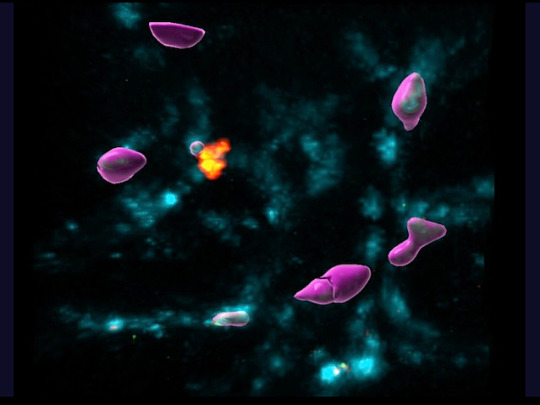
T for Tolerant
Single cell analyses and live-imaging in mouse gut reveals mechanisms underlying tolerance of the immune system's regulatory T cells to chronic bacterial infection and the intestinal niches where this takes place. Greater understanding of the disruption of tolerance which results in colitis
Read the published research article here
Still from video from work by Yisu Gu and Raquel Bartolomé-Casado, and colleagues
Kennedy Institute of Rheumatology, NDORMS, University of Oxford, Oxford and Wellcome Sanger Institute, Wellcome Genome Campus, Hinxton, Cambridge, UK
Video originally published with a Creative Commons Attribution 4.0 International (CC BY 4.0)
Published in Nature, April 2024
You can also follow BPoD on Instagram, Twitter and Facebook
#science#biomedicine#immunofluorescence#biology#immunity#immune response#colitis#inflammation#gut bacteria#microbiome
11 notes
·
View notes
Text
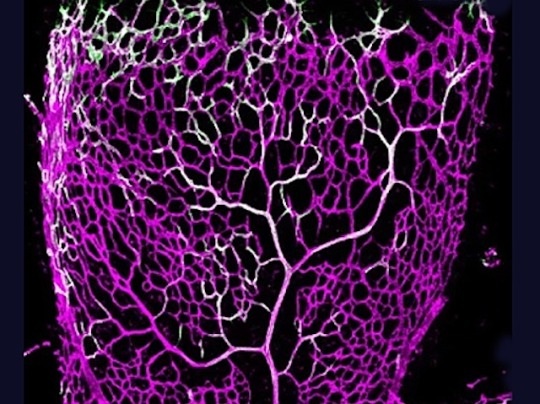
Leading to Arteries
The right balance of ephrin-B2 protein and its receptor EphB4 is critical for the formation of arteries – insight for treating human vessel malformations caused by mutations in the EPH4B gene
Read the published research article here
Image from work by Jonas Stewen and colleagues
Department of Tissue Morphogenesis, Max Planck Institute for Molecular Biomedicine, Münster, Germany
Image originally published with a Creative Commons Attribution 4.0 International (CC BY 4.0)
Published in Nature Communications, April 2024
You can also follow BPoD on Instagram, Twitter and Facebook
11 notes
·
View notes
Text
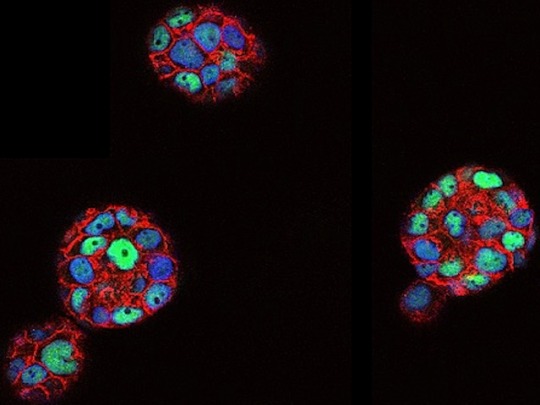
In the Round
Molecular and physical differences revealed between breast cancer cells lab-grown on a flat surface in 2D versus in 3D as spheroids – the nucleus of the 3D-grown cells is more rounded, has a larger surface, a more compact chromatin [DNA packaged with proteins in the nucleus] and a distinctive set of downregulated genes
Read the published research article here
Image from work by Julieta Ramirez Cuellar and Roberto Ferrari, and colleagues
Center for Genomic Regulation (CRG), Barcelona Institute for Science and Technology (BIST), Barcelona, Spain
Image originally published with a Creative Commons Attribution 4.0 International (CC BY 4.0)
Published in EMBO Journal, April 2024
You can also follow BPoD on Instagram, Twitter and Facebook
#science#biomedicine#immunofluorescence#biology#organoids#spheroids#cell nucleus#cells#chromatin#cell culture#breast cancer
15 notes
·
View notes
Text
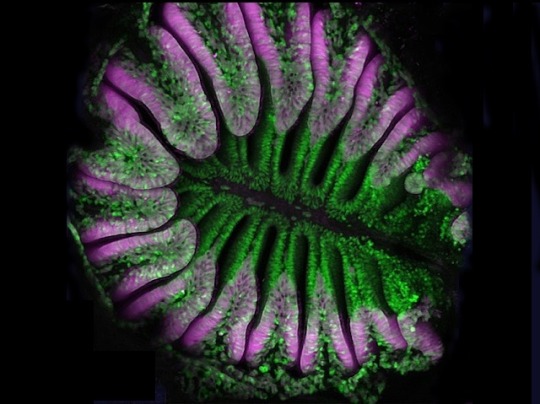
Equipped to Smell
Regulation by a transcription factor called Foxj1 underlies the molecular signals for development and differentiation of olfactory receptor neurons and their hair-like non-motile cilia vital for a vertebrate's sense of smell
Read the published research article here
Image from work by Dheeraj Rayamajhi, Mert Ege and Kirill Ukhanov, and colleagues
Institute of Molecular and Cell Biology, Agency for Science, Technology and Research, Singapore and Department of Clinical and Molecular Medicine, Norwegian University of Science and Technology, Trondheim, Norway
Image originally published with a Creative Commons Attribution 4.0 International (CC BY 4.0)
Published in PLOS Biology, January 2024
You can also follow BPoD on Instagram, Twitter and Facebook
7 notes
·
View notes
Text

Modelling Beige
Metabolically active fat tissue of the zebrafish heart bears genetic, molecular and metabolic hallmarks of the same tissue in humans – a new model for studying the activity of mammalian beige adipose cells in relation, for example, to obesity
Read the published research article here
Image from work by Paul-Andres Morocho-Jaramillo and colleagues
Max-Delbrück-Center for Molecular Medicine in the Helmholtz Association (MDC), Berlin, Germany
Image originally published with a Creative Commons Attribution – NonCommercial – NoDerivs (CC BY-NC-ND 4.0)
Published in Cell Reports, March 2024
You can also follow BPoD on Instagram, Twitter and Facebook
#science#biomedicine#immunofluorescence#biology#fat#obesity#adipose tissue#brown fat#white fat#beige fat#heart#endocardium#zebrafish
4 notes
·
View notes
Text

Glial Diversity Atlas
Study in fruit flies of the relationship between the shapes (morphologies) of distinct glial cells – non-neuronal cells of the nervous system – and their gene activity (transcription) reveals several new morphologies but no clear correlation with the transcription signatures
Read the published research article here
Image from work by Inês Lago-Baldaia and colleagues
Department of Cell and Developmental Biology, University College London, London, UK
Image originally published with a Creative Commons Attribution 4.0 International (CC BY 4.0)
Published in PLOS Biology, October 2023
You can also follow BPoD on Instagram, Twitter and Facebook
7 notes
·
View notes
Text
Staunch Supporters
Bacterial toxins can compromise blood vessels' leakiness affecting blood pressure. This study reveals that blood vessel lining cells' membranes, under the control of proteins called caveolin-1 and cavin1, stiffen to regulate the leakiness via tunnels called transendothelial cell macroapertures
Read the published the research article here
Video from work by Camille Morel and colleagues
Institut Pasteur, Université Paris Cité, CNRS UMR6047, Inserm U1306, Unité des Toxines Bactériennes, Département de Microbiologie, Paris, France
Video originally published with a Creative Commons Attribution 4.0 International (CC BY 4.0)
Published in eLife, March 2024
You can also follow BPoD on Instagram, Twitter and Facebook
23 notes
·
View notes